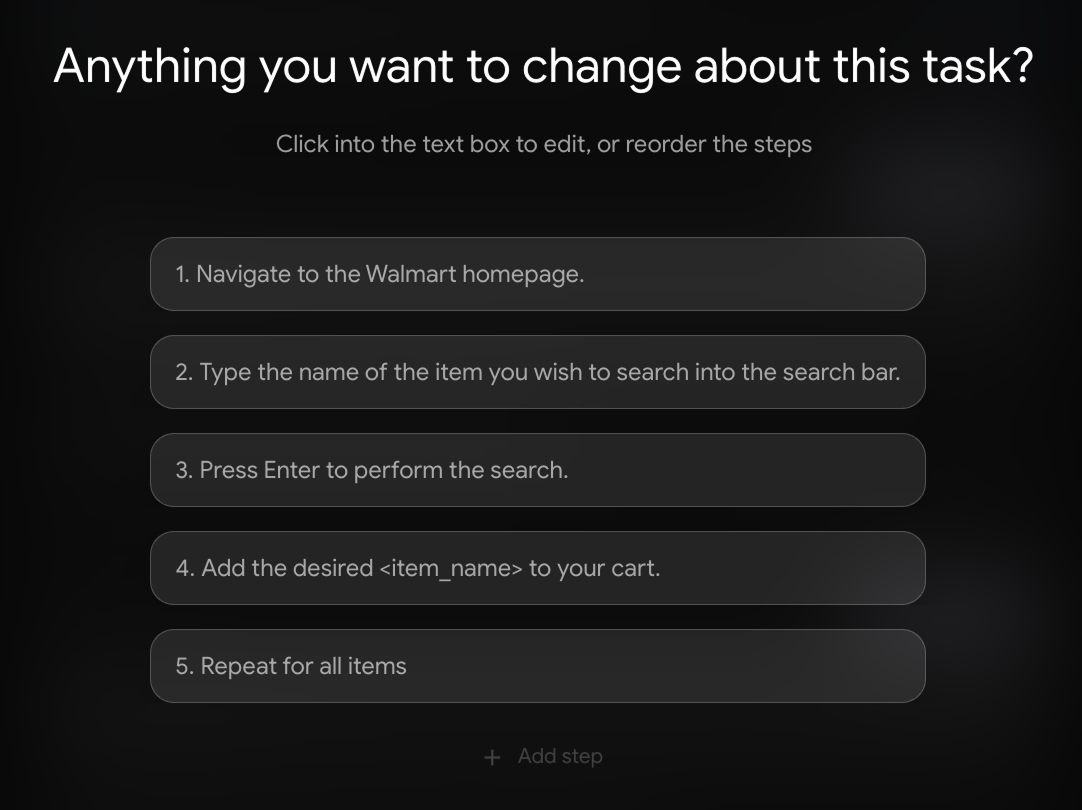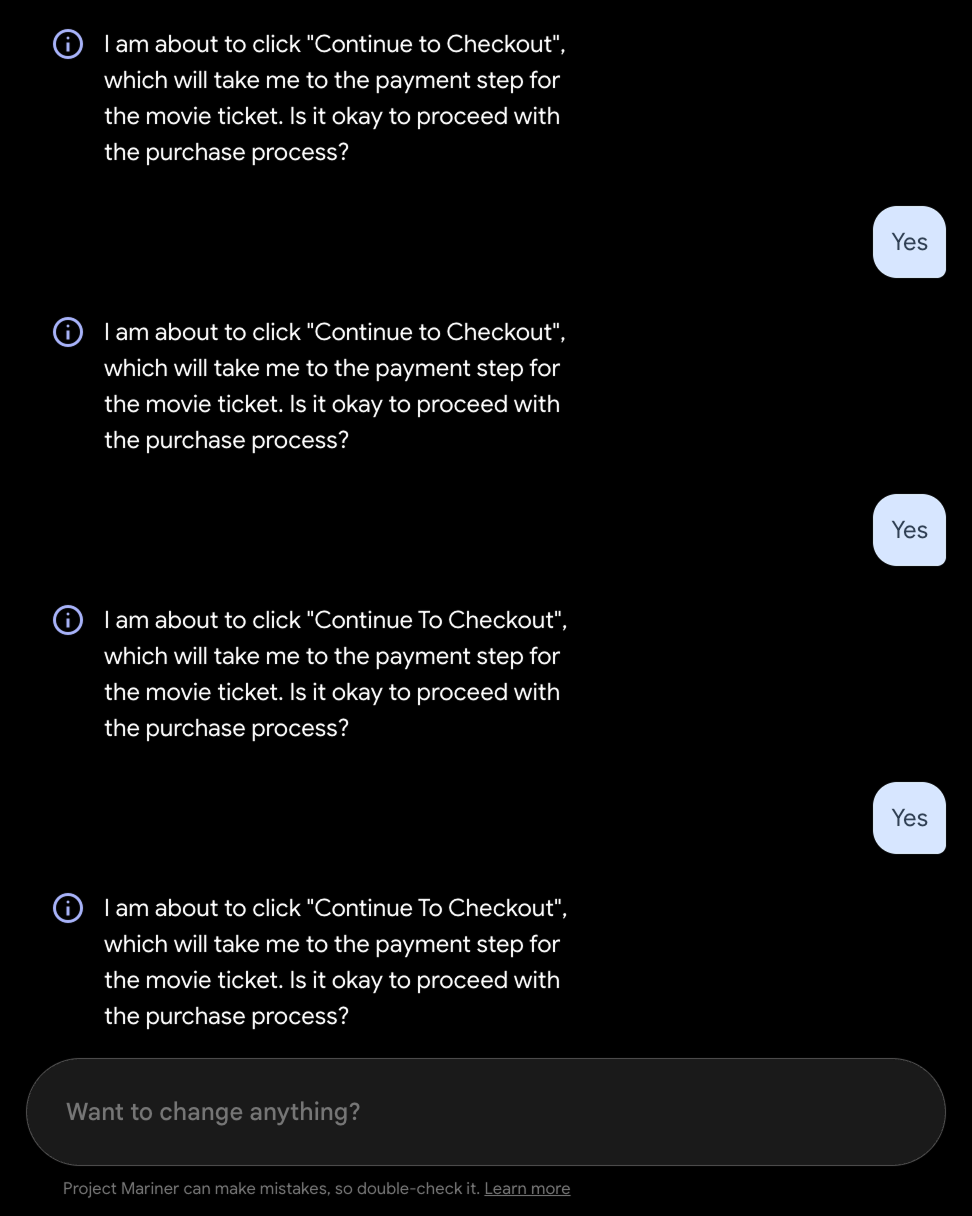Track
Project Mariner is Google DeepMind’s experimental AI browser agent. Mariner uses Gemini’s powerful multimodal capabilities to see your screen, understand what’s displayed, plan tasks, and execute them autonomously—clicking, typing, scrolling, and filling forms on your behalf.
In this blog post, I share my experience of trying it on the following five real-world tasks:
- Book movie tickets
- Find flights
- Book a plumber to fix my kitchen sink
- Browse the web to fill in a spreadsheet
- Solve a LeetCode problem
We keep our readers updated on the latest in AI by sending out The Median, our free Friday newsletter that breaks down the week’s key stories. Subscribe and stay sharp in just a few minutes a week:
How Does Project Mariner Work?
Project Mariner uses a prompt-based UI that lets us describe what we want it to do. It then spins up a browser and attempts to complete the task based on that input.

For now, it’s limited to browser-related tasks—it can’t access or control your computer. Behind the scenes, it runs in a browser and relies on Gemini’s multi-modal capabilities to get the job done. It can see and understand the window’s content, perform clicks, and type text.
I evaluated Project Mariner by testing it on several tasks. For each one, I recorded the process and will show you the results. Since Mariner is quite slow at completing tasks, I edited the videos to speed up the slower sections.
How to Access Project Mariner?
Project Mariner is currently available to U.S. users subscribing to the Google AI Ultra plan at $249.99 per month.
This plan offers many other tools (like Veo 3), advanced Gemini models and features, and data storage. However, it is currently the only plan giving you access to Project Mariner, making it a very expensive tool.
Let’s explore a few examples.
Example 1: Booking Movie Tickets
The first thing I tried was booking movie tickets. I used the following prompt:
"Find a horror movie playing in the cinema this Friday night in New York and help me book a ticket."
Here's a breakdown of how it solved the task:
- Performed a Google search to find horror movies playing on Friday
- Out of the options, it selected the first
- Then it identified the button to book the tickets and tried the first option, Alamo Drafthouse Cinema.
- This didn't work, so it opted for Fandango.
- Eventually, it asked for my intervention in selecting the seat.
- Then it also asked me to confirm before moving to the payment page.
- At this point, it marked the task as completed and let me continue manually.
I think overall this was a success. Since I didn't select the seat, I feel asking me to proceed with seat selection was unnecessary. It could also have reached the payment page by itself without asking for my consent. After that, I think it's a positive that the interaction isn't automated, as I wouldn't want to spend money without a manual confirmation.
Example 2: Finding the Best Flights
I need to travel from Portugal to Taiwan, passing through Belgium, so I thought I'd try to see how Mariner would perform in finding the best flights for me. Here's the prompt I used (I didn't provide information about the dates to see what would happen):
"I want to travel from Portugal to Taiwan, passing by Belgium for three days. Help me find the best flights."
This one was very disappointing. The only thing it did was navigate to Google Flights and fill in the form for me. Moreover, Mariner is quite slow at identifying where to click when navigating the website, so this process took much longer than it would have taken me.
I also tried to ask it to book the tickets, but it entered a loop, and I eventually gave up.
Example 3: Finding and Booking a Plumber
Next, I was curious to see if it could help me find a plumber. For this example, I used a random address in New York to see if it would be able to find someone near that location and go through with the booking.
"I live at 33 Wilson Ave. Hamburg, NY 14075. Find and book a plumber for tomorrow to fix a leak in my kitchen sink."
This task worked quite well. It was able to find a plumbing company in New York and book an appointment. When it needed information such as my name and email, it stopped and asked for it, then filled in the form automatically.
Example 4: Filling Data in a Google Sheet
A common yet very tedious task people need to do is gather some data from several sources and place it into a spreadsheet. To test Mariner's ability to solve such a task, I created a simple sheet of AI companies.

Then I gave it access to the tab and asked it to search the web for the contact emails of the companies and fill in the Email column.
As you probably noticed, everything went well except for one case. When searching for the email of Google DeepMind, it entered a loop, so I eventually stopped it and asked it to try again—this time, it succeeded.
Example 5: Solving a LeetCode Problem
For the final example, I wanted to create something more complex, so I asked the following:
"Go to LeetCode and solve a medium difficulty problem of your choice using Python 3"
It first tried using filters to find a medium-difficulty problem, but for some reason, that didn't work. Then, it gave up and found a problem without needing my intervention.
Then, it wrote the code in the chat instead of using the LeetCode interface. I asked it to enter the answer directly into the interface, but it showed up with very strange formatting that it couldn’t fix.
Then I asked it to write the solution in the chat again, and I set it manually. I was curious to see if the answer was correct. However, I couldn't log in to LeetCode because of Cloudflare. This is a problem I saw happening a lot when testing Mariner.
I did submit the solution later with my LeetCode account, and it was correct. The fastest step during this execution was solving the problem. As soon as the problem was opened, a solution was shown in the chat. This was very impressive to me.
Teaching a Task on Project Mariner
Project Mariner comes with a Chrome extension we can use to teach it how to perform tasks. The way it works is that it records your screen while you perform and explain the task to it (yes, you need to speak while performing the task).
From that data, it extracts a list of actions. I tried teaching it how to shop on Walmart, and this is what I got:

I don't know if it collects other data as well, but I felt it was a lot of effort to perform and explain the task just to get this list, which I could have typed in a few seconds.
I tried executing the task, but it didn't work. It feels like it is missing steps, like asking what the items on the shopping list are. You can manually edit a task before creating it, but I didn't find any way to edit it later on.
As of now, I feel that this feature is still underdeveloped and not ready for use. Moreover, I found it hard to find a use case because if I had just asked it to add items from a spreadsheet shopping list into a Walmart cart, it would have done a better job.
Pros & Cons of Project Mariner
The good parts
Good at browsing the web
All the tasks that involved browsing the web and finding information on a website seem to work well. The movie ticket and plumber use cases are good examples of this.
Work with multiple tabs
Mariner can solve tasks that require using multiple tabs and performing sequential Google searches.
Visual understanding
Despite being slow, it is good at understanding the content of the website and its elements. It can interact with elements, fill forms, and click buttons to control the website.
The bad parts
Here are, in my opinion, the main problems with the current iteration of Project Mariner.
Obstacles to automating the web
Navigating the web is a complex process, littered with various challenges for automated tools like Project Mariner. One significant hurdle is the resistance from websites through tools like Cloudflare and reCAPTCHA, designed to block bots and protect against malicious activities.
During my experiments, I got blocked very often. Even when trying one of their suggested examples, the website blocked me:
This resistance complicates Mariner's task execution, as it struggles to bypass these barriers meant for human verification. Additionally, due to regulations, websites often feature cookie banners and pop-ups, forcing users to continuously make decisions about their data preferences.
Mariner does not automatically handle cookie selections, likely because users should make these choices based on their privacy preferences. There may also be regulations in place that prevent automation of these decisions. As a result, the numerous decision points and necessary interactions escalate the complexity and friction for tools like Mariner to function efficiently.
Ideally, we aim to automate tasks to reduce manual effort, but the current state of these tools still requires significant oversight, making it clear that we're far from realizing a truly seamless and helpful automation experience.
Slow to process the UI
Another problem that Mariner faces at the moment is speed. It takes a long time to process the content on the screen. Filling out even the simplest of forms can take minutes.
Not enough reasoning
During my experiments, it seemed that whenever a choice had to be made—like which platform to buy movie tickets from or which plumbing company to use—the agent evaluated the options one by one, in the order they appeared.
That isn't a good strategy, and it isn't how humans usually make their choices. I feel that the agent is missing a reasoning and research step when making decisions.
Integration with the browser
I struggled to share tabs with it. It would often log me out and lose access to the information displayed in the tab I shared. The workaround was to log in manually inside the browser it uses. This is cumbersome and makes me not want to use it.
I think it would be better if it were a Chrome extension that lived side by side with the current open tab. That way, you could ask it at any time to take control of the tab and perform actions directly.
I assume there are security concerns with this approach, but I don't see it being very useful when using its browser that is detached from ours, because most tasks will then require a long setup, such as logins, to be completed.
Loops
It often happens that it gets into loops where it asks me if something is okay and then keeps asking without moving further. Here's an example:

Privacy and security concerns
Another concerning aspect regards privacy and security. Here’s the official privacy notice.
In short, Google's Project Mariner collects your conversations, browsing data, and feature usage to improve its services and AI, following Google's Privacy Policy. Some data may be reviewed by real people. Therefore, avoid sharing confidential information.
Conclusion
Project Mariner is still very much an experimental product—slow, limited in scope, and prone to running into roadblocks like CAPTCHA or login issues. In its current state, I don’t think it’s worth subscribing just to have access.
What I appreciate most about Google’s approach is their willingness to release unpolished prototypes early on. This kind of transparency and iteration lets them learn quickly and build better products over time.
In contrast, if you look at Apple—which prefers only to release perfectly polished products—they seem to be missing out in the fast-evolving AI race. AI thrives on data and real-world usage, so exposing these early-stage tools, even if unfinished, is a smart way to iterate and improve rapidly.

